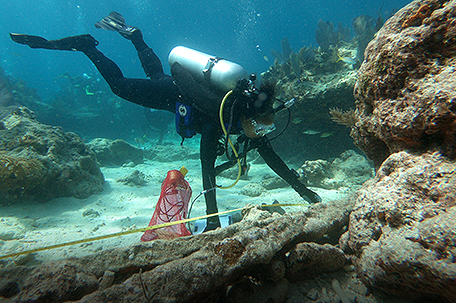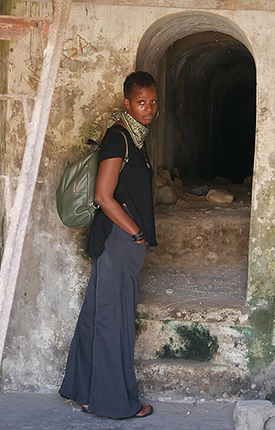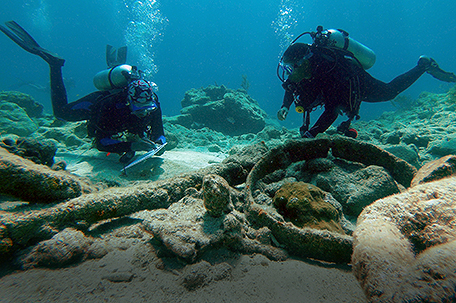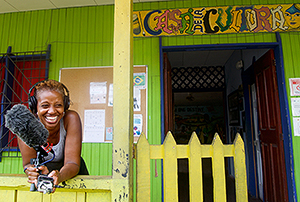
In her new National Geographic podcast “Into The Depths,” journalist Tara Roberts tells the story of the Transatlantic Slave Trade through the ruins of the slave ships that made the trip.
ABOVE PHOTO: Sabrina Johnson measuring an artifact. Photo By: Brenda Altmeier (NOAA)/Courtesy of Chris Searles
By Denise Clay-Murray
A picture can say a thousand words.
For Tara Roberts, a picture at the National Museum of African American History and Culture in Washington, DC said so much that it became a story that she couldn’t resist telling. The picture, which was part of an exhibit on the second floor of the NMAAHC, was of a group of Black, mostly female scuba divers hugging a Black man on a boat. The man was Dr. Albert Jose Jones, a marine scientist, Fulbright scholar and retired professor of Marine Science at the University of the District of Columbia.
He is also considered the grandfather of Black scuba diving as the founder of the National Association of Black Scuba Divers and co-founder of Diving With A Purpose.
“There was something about the picture that just captured my imagination,” Roberts said. “I’m a huge lover of the water, the world of adventure and activity, so it just caught my eye. And then when I read the explanation about the photo, it said it was this group called Diving With A Purpose and that they participated in missions to search for and help document slave shipwrecks around the world.”
“I was blown away with just this idea of Black folks under the water, doing the work to find our history,” Roberts continued. “When I decided to tell the story, I didn’t have a plan. I didn’t have an assignment. I didn’t have funding. I just knew that this was something important for, like, the world to see.”

And that fascination, along with learning the story of Diving With A Purpose and its work towards uncovering the truth of Transatlantic Slave Trade led Roberts — a storytelling fellow with National Geographic — to create the podcast “Into The Depths.”
The six-part series and the accompanying article in the March edition of National Geographic Magazine follows Roberts as she connects with Diving With A Purpose, trains to go on dives, and learns more about this period in history at a time when that knowledge is taboo in some spaces.
The SUN spoke to Roberts about “Into The Depths,” the stories she still hopes to tell about this history, and how it inspired her to learn more about herself and her family in the process.
SUN: Thank you for taking the time, Ms. Roberts. Can you talk a little bit about how you connected with Diving With A Purpose and how you were able to put together this project?
TR: I ended up reaching out to them. I wasn’t thinking about diving at that time. I was thinking, like, ‘Wow, they’re doing great work, can I help support them in some way?’ And so, I ended up having conversations with [Albert Jose Jones]. He and I had some long, beautiful conversations. And then he invited me to come dive with them. But to come dive with them, it meant I had to go get my scuba certification. He said, and this is also something that was completely surprising to me, that Washington DC is the epicenter of Black scuba diving. All the legends live in DC. [Jones] is the one who started the very first Black scuba diving club in DC. And in 2019, that Club celebrated its 60th anniversary.

Right now, the club has over 100 active scuba divers, and they go on trips together around the world. So, you can imagine, like, a group of 100 people strong showing up at a dive destination, and they come to party. They’re beautiful and loud and wonderful. And they’ve got skills; like, these guys know how to dive. Dive club — it’s called the Underwater Adventure Seekers, and they took me into their class.
I spent three months learning or getting trained on scuba with them, and during that process, I got to know these incredible human beings — they were funny, they were passionate. They were generous, because all of these folks just donated their time to help train up other Black folks who wanted to learn how to scuba dive. I thought that they were really special, and at some point, I was — somebody should tell their story. People need to know that these people exist, that this world of Black scuba divers is here. So, I was, ‘Hey, wait, I’m a journalist. Maybe I should help tell that story.’ And that’s how it all got started.
SUN: So, what were you doing at the time that you decided to do this story? Because from what I understand you quit your job to do this. And you were with these folks for two years.
TR: Yeah, so I was working for a nonprofit in DC. And it was a really great nonprofit. It seemed like a great job. I was director of communications, and it was wonderful. And I felt like something was still missing — there was something more that I wanted to do in that time. Most of the work that I’ve done in the past has really been centered around women’s empowerment and gender equity. I worked at Essence for a long time. I published my own magazine. I started a nonprofit that supported young women changemakers around the world. I’ve done a couple of books that focus on, like girl empowerment. I was really in that space. But around 2016, 2017, more issues around race were coming up to the fore. And I’m a Black woman, so, you know, race has always been present for me. But these issues of identity were in the national landscape in such a big way that I started to feel like I wanted to shift my work and my attention around race more, and that wasn’t a focus at the nonprofit I was at. So, I just wanted to do more in that space.
And then I came across the divers. I fell in love with them, fell in love with their stories and I love their mission. A lot of the members of the Underwater Adventure Seekers were instructors with Diving With A Purpose. So, I really got to hear and learn more about DWP, and I wanted to do something with it. I couldn’t do that working a full-time job. So, in 2018, in February, I left my job. I didn’t know how I was going to do all of this, but I knew I wanted to.
SUN: What did you do next, and how did you connect with National Geographic?
TR: I wanted to participate in the Diving With A Purpose training, so I really understood what it takes to map a shipwreck. I really wanted to be involved with it. So, to participate with Diving With A Purpose, you have to get at least 30 ocean dives under your belt to prove that, you know, you can handle yourself underwater. So, I was like, ‘Alright, I’m going to take some savings, I am going to Southeast Asia. And I’m going to get my dives in and I’m also going to sit on a beach and meditate, write in my journal, and figure out how I can really do this work.
I was getting my skills together diving, getting myself in the right mindset, and figuring out how I was going to do it. It was in that moment that I came across the National Geographic Explorers grant. I used to read [National Geographic] as a kid and I loved the stories of adventure. I loved the idea that, there are all these people around the world that are, you know, doing interesting, amazing things.
I ended up getting, seeing the application right before the grant was due. So, I sat on a beach and did the application. I didn’t know if anything was gonna happen with it. In September, I found out that I got the grant from NatGeo. And so, that grant gave me the funding to travel to all the locations around the world.

Part of my grant was to write blog entries about my travels. So, as I got to new places, I was writing these short, 200-300 word pieces about what I was experiencing and what I was learning about these divers and about the work in action. Very quickly, I realized that it was big history and big work. It was stories about the ships, it was stories about people who were lost on the ships. It was about the global slave trade. It was this world that I only knew a little bit about, because of the way that we’re taught the history of the Middle Passage. There’s so much more to understand about that moment in time, and I’d never thought to look at it from the angle of the ocean and what was happening around that crossing.
SUN: How did it evolve to become a podcast?
TR: The more that I hung out with these divers — and not just divers — I was also talking to historians, talking to archeologists, talking to descendants of the people who were on the ships, really engaging with communities in these areas. The story kept growing and getting bigger, and it had more and more layers. And I was like, I can’t capture all of this in 200 to 300 words. So, I went back to NatGeo. And by this time, they were really invested in the story. They had started to invest in the discovery of the Clotilda, which is the ship that was most recently found in 2019. I went back to them and said ‘I hear this as an audio story.’
As I heard all these voices and accents and all these people from all kinds of walks of life, who were thinking about the Middle Passage in the global slave trade in a way that I’ve never even thought to think about it, I wanted to hear from them. And I would love for other people to be able to hear from them. So, they agreed with me and ended up investing in turning this into a narrative podcast.
SUN: Where were some of the places you went to, and what did you find?
TR: I went to Mozambique, South Africa, Senegal, Benin, and Togo. There isn’t any work being done to recover ships in Benin and Togo, but I went there, because many of us African Americans can trace our roots back to Benin and Togo and I was so close. I wanted to go visit and to walk the slave trails. I wanted to see what it was like before the people got put on the ships, I wanted to stare at the Doors of No Return, visit the barracoons, and really understand that piece as well. So, Benin and Togo, Costa Rica, St. Croix, and then in the US — Florida and Alabama is where work is happening. And I was able to dive in a few locations.
SUN: This had to be an emotional experience for you.
TR: Yeah, it is. But I will say that it’s emotional in a different way than people might expect. It was different than what I expected. Before I started on its journey, I created a little community, like a virtual community of people to hold space for me, because I didn’t know how hard this was going to be. If it would be really sad — I would feel traumatized as a result of engaging in this work. So, I was prepared for that. But what I found as I traveled was something different. I actually found that engaging with this work was healing in a way that I hadn’t expected. There’s something about actually seeking the evidence. It’s evidence that can’t be denied. There’s something about facing that evidence and saying, ‘I am taking on the responsibility to help find this history to help witness for these people whose stories have not been told, whose experience has pretty much been erased from our history books.’ I’m taking on the job of helping to find that history and bring it up from the depths. It’s powerful and it’s healing and it brings closure to it. A lot of the ways that we talk about our story, we — and when I say we, I mean like the way the world looks at Black history — we sit in the pain, we sit in the trauma, we sit in the horror. This work is about healing that space. It’s about facing it and bringing closure to what happened. And so, it feels like it’s a different process.
SUN: Did you find out anything about your own family through doing this project?
TR: As I engaged with this history — especially as I met descendants, who were connecting to specific ships — it made me start to for the first time like wonder if I could trace my own family back to a slave ship. Even though my family is really into ancestry and into genealogy, I wasn’t that curious. My mom has pictures of some of our ancestors on her wall, and we can trace our back to my great, great grandfather Jack. I would pass by that picture. And, you know, like, I would be like, Okay, that’s great. But there was sort of a mild curiosity, or at best, or really sort of at worst, it was kind of indifference to that. And I think that what I discovered is I didn’t really realize this, it was because there was a part of me that was just really afraid to face the fact that my ancestors had been owned by someone else in there was someone else’s property.
But through this process, I got more curious. And I saw the strength and the pride that like the descendants of the ancestors had for their ancestors, and what that gave to them and how it rooted them as a people and as individuals. So, I got curious, and I hired a genealogist, and I was, ‘Hey, can we trace our family back to a particular shipwreck?’ And of course, it turns out that we couldn’t, because of this thing called the 1870 brick wall, which means that the US Census, did not track enslaved people before 1870. So, it makes it really hard for us to go back.
What she thought that we could do, though, was find out more about great, great Grandpa Jack, who was born in 1837. And he was born enslaved in North Carolina, in an area called Chihuahua County, and now it’s Eatonton, North Carolina. Turns out, we couldn’t find out more about his parents. But we did find out these details about Jack that I did not know and that my family didn’t know. I found out that Jack fought in the Civil War. He was in the United States Colored Troops. I found out that he had amassed all this land. I realized that he was an inspiration, and that ended up healing something for me that I didn’t know needed to be healed. It made me less afraid to engage with the past, and it rooted me inside of myself in a way that I didn’t know I needed. I think it changed me in a lot of ways.
SUN: What’s next for you? Is this the end of this project for you?
TR: To date, less than 10 of the thousands of slave ships that were wrecked have been found and properly documented. So, there’s a whole lot of history out there to be found, a whole lot of stories. So, I think that there’s a lot more work to be done. There’s so much more work that I want to be doing around this project.
In addition to “Into The Depths,” National Geographic presents the documentary “Clotilda: Last American Slave Ship,” which tells the story of the discovery of the Clotilda, a ship that carried 110 kidnapped Africans to slavery in Alabama in 1860. The documentary is currently on Hulu.
New episodes of the “Into The Depths” podcast premiere on Thursdays and can be heard on Apple Podcasts, TuneIn, Spotify or anywhere else you get your podcasts.

















Leave a Comment